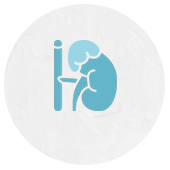Obesity and Cancer Exp Clin Endocrinol Diabetes
Obesity and Cancer Exp Clin Endocrinol Diabetes
2009; 117: 563 – 566
Authors R. Percik 1 , M. Stumvoll 2
Affiliations
1. Institute of Endocrinology, Sheba Medical Center, Tel-Hashomer, Israel
2. Department of Medicine, University of Leipzig, Leipzig, Germany
Abstract
Epidemiological studies have suggested that
obesity is associated with increased risk of several
cancer types including colon, esophagus, breast
(in postmenopausal women), endometrium, kidney,
liver, gallbladder and pancreas. Suggested
mechanisms include increased intake of potentially
carcinogenic food ingredients along with
excessive amount of calories, loss of cancer protective
eff ects due to reduced physical activity,
carcinogenic factors released from increased adipose
tissue mass and “ secondary ” associations
via “ precursor ” condition such as gallstones. The
increased cancer risk in patients with obesity is
a neglected topic which deserves more scientifi c
attention. Because of its extreme chronicity and
co-association with numerous other conditions
true causality and underlying mechanisms are
diffi cult to study. Nevertheless, a large body of
literature is already available which provides
concepts for future research.
“ Corpulence is not only a disease itself, but the
harbinger of others ” Hippocrates wrote 2,500
years ago, recognizing that obesity is both a medical
disorder and a cause for many other co morbidities.
Since the early 1960, when obesity was a
minor problem epidemiologically, with the accelerating
increase in its prevalence during the 80s
and 90s, the mean BMI increased by 3 BMI units
approximately in both genders. This translates
into an increase of 9 kg while average height only
increased by less than 2 cm. Alarmingly, the same
trend applies to children [1] . Excess bodyweight
is the sixth most important risk factor contributing
to the overall burden of disease worldwide.
1.1 billion adults and 10 % of children are now
classified as overweight or obese. Current epidemiologic
trends in obesity suggest that the steady
rise in life expectancy during the past two centuries
may soon come to an end [2] . In a 40-yearold
obese person the average life expectancy is
already diminished by 7 years. The relationship
between excess body weight and morbidity
including cardiovascular disease, type 2 diabetes
mellitus, hypertension and osteoarthritis has
been firmly established. Several forms of cancer,
including endometrium, colon, renal cell and
esophageal cancer are also associated with
obesity [3, 4] . The WHO International Agency for
Research on Cancer estimated that overweight
and inactivity account for a about a quarter of
these cancers [5] . The mechanisms that link
obesity and cancer have not been fully elucidated
and are being intensively investigated in many
fields of basic science. The topic has been covered
by a number of excellent reviews [6, 7] . While the
mechanism linking obesity with metabolic and
cardiovascular disease seem to be operative on a
more accessible time scale, those involved in cancer
are probably more subtle and slower. Clearly,
any individual cancer is far less prevalent than
coronary heart disease or type 2 diabetes, for
example. Therefore, establishing epidemiological
and mechanistic associations between obesity
and cancer is challenging.
Epidemiologic Evidence
Epidemiological studies have suggested that
overweight and obesity are related to increased
risk of several cancer types, including colon cancer,
adenocarcinoma of the esophagus, breast
cancer (in postmenopausal women), endometrial
cancer and kidney (renal-cell) cancer. Epidemiological
evidence also indicates that cancers of the
liver, gallbladder and pancreas are obesity related,
and that obesity might also increase the risk of
some hematopoietic cancers and aggressive forms of prostate cancer [8] . Data from other cancers have been
inconsistent [9] . Estimates suggest that 14 % of all cancer deaths
in men and 20 % of all cancer deaths in women are attributable
to overweight and obesity [10] .
Obesity has been consistently associated with higher risk of
colorectal cancer in both case – control and cohort studies [3] .
Similar relationships are seen for colonic adenomas which are
considered carcinoma precursors. Obese men are more prone to
develop colorectal cancer than obese women, a consistent observation
across studies and populations. Abdominal adiposity is
thought to account for this difference. Obese women have a 30 –
50 % higher risk of breast cancer in postmenopausal years
[11, 12] . There is convincing and consistent evidence from both
case – control and cohort studies that overweight and obesity are
strongly associated with endometrial cancer [10, 13] . Studies of
populations worldwide have revealed that the risk of kidney
cancer (specifically, renal-cell cancer) is 1.5 – 3 times higher in
overweight and obese individuals than in people of normal
weight [14, 15] .
The incidence of adenocarcinoma of the esophagus has been
rapidly increasing in western countries in recent decades [16] .
Independent of obesity, gastro-esophageal reflux disease
(GERD) has been associated with esophageal adenocarcinoma
and with its metaplastic precursor, Barrett’ s esophagus [17] .
Obesity has therefore been proposed to increase the risk of adenocarcinoma
of the esophagus indirectly, by increasing the risk
of GERD and Barrett ’ s esophagus [18] . Results from many
recent studies indicate that obesity is associated with an almost
twofold increased risk of pancreatic cancer [19, 20] . The majority
of studies on liver and gallbladder cancer found an increased
risk among obese individuals [21, 22] .
Suggested Mechanisms
Obesity is a state of increased body fat mass caused by a prolonged
positive energy balance. This is accompanied by a wide
range of physiological and biological alterations. The mechanisms
and pathways involved in obesity-related carcinogenicity
are multifaceted and difficult to extricate. We have defined four
groups of mechanisms: 1) increased energy intake, 2) decreased
energy output, 3) increased adipose tissue mass and 4) “ secondary
” associations. Intake includes both the amount of consumed
calories and the dietary composition. Energy output is equivalent
to energy expenditure and can be viewed as a cancer protective
mechanism. Increased adipose tissue as a potential
source of metabolic and endocrine modulators of oncogenic cascades
will be described in more detail and finally two examples
for indirect or secondary associations will be given ( ● ▶ Fig. 1 ).
Increased energy intake
Diet is one main determinant of body composition and dietary
factors are thought to account for about 30 % of cancers in Western
countries [1] . Thus, diet is second only to tobacco as a modifiable cause of cancer. Not only the quantitative caloric intake
but also the composition of consumed food has potential carcinogenic
effects. The majority of case control and prospective
studies imply a causal relationship between increased caloric
intake and breast, colon and prostate cancer [23] . Caloric restriction
has never prospectively examined as a preventive intervention
in humans. Obesity virtually by definition is a result of
overeating, not only of energy-rich compounds such as fat, but of pretty much everything contained in modern food including
complex proteins, toxins and artificial food additives whose
metabolic derivatives (e. g., toluols, nitrites) may contribute to
large bowel carcinogenesis and other malignancies [24] .
Decreased energy output
In addition to reduction of adipose tissue mass and its detrimental
metabolic and endocrine consequences, especially reduced
pro-inflammatory cytokine expression, physical activity is independently
associated with reduced mortality from cancer.
Potential mechanisms include the reduction of oxidative stress
and the increase of protective cytokines [25] .
Increased adipose tissue mass
The endocrine function of adipose tissue is altered when it
becomes hypertrophic or hyperplastic. Both conditions, but
more so the former, can result in significant changes in hormone
and growth factor secretion. This can have complex consequences
on intracellular pathways involved in inflammation, cell
proliferation, oxidative stress and carcinogenesis.
Insulin and IGF-1 pathways
Chronic hyperinsulinemia and insulin resistance increases risk for
several malignancies [6, 26– 28]. The mechanisms are not fully
understood but may involve direct growth promoting effects of
insulin or indirect eff ectsvia stimulation of the IGF-1 receptor or
modulation of the release of other hormones. Both insulin and
IGF-1 act in vitro as growth factors to promote cancer cell proliferation
and decrease apoptosis [26] . This topic will be covered in
more detail by a separate mini-review in this series.
Hyperglycemia
Although difficult to separate from diabetes mellitus, hyperglycaemia
per se, including transient and mild forms such as in
obesity-related pre-diabetic states, is considered to possess carcinogenic
potential. Like in diabetic complications increased levels
of reactive oxygen species and accumulation of advanced
glycation end products (AGEs) may play a role. Bound to their
receptor, AGEs induce inflammation by activating the transcription
factor NF-kB and inducing the formation of intracellular
ROS [29] . This may adversely interfere with DNA-repair mechanisms,
for example. Inflammation
Hypertrophied adipose tissue has been shown to release inflammatory
adipocytokines including IL-1, TNF- α and plasminogen-
activator inhibitor – 1 (PAI-1) [30] which affect cell growth,
survival, proliferation and angiogenesis. The association between
chronic inflammation and cancer has been studied in greater
depth in other conditions such as inflammatory bowel disease
which carries an increased risk of colonic cancer [31] .
Leptin
This hormone is secreted from adipocytes and links fat cells and
positive energy balance to satiety, fertility and other endocrine
and metabolic pathways. Obesity is associated with high circulating
levels of leptin, probably as a consequence of central leptin
resistance. Consistent findings link hyperleptinemia to colon
cancer [32] . In vitro, leptin stimulates proliferation of multiple
types of preneoplastic and neoplastic cells [33] . The Janus kinase
2 / signal transducer and activator of transcription 3 (JAK2 / STAT3)
pathway is the main downstream channel through which leptin
exerts its metabolic and proliferative effects, in addition to activation
of AMPK in muscle and liver [34] . There are increasing
data suggesting crosstalk between the JAK / STAT family of transcription
factors, the insulin / IGF-1 / Akt pathway and AMPK [35] .
Leptin also functions as an inflammatory cytokine and appears
to influence immune function, possibly by triggering release of
interleukin-6 and other cytokines [33] .
Sex hormones
Adipose tissue aromatase converts androgenic precursors produced
in adrenals and gonads to estrogens. Increased insulin
and bioactive IGF-1 levels that typically accompany obesity
down-regulate levels of sex hormone binding globulin (SHBG),
resulting in an increased fraction of bio available estradiol and
possibly testosterone. The epidemiologic literature suggests this
increased bioavailability of sex hormones, especially estrogen, is
strongly associated with risk of endometrial and postmenopausal
breast cancers [13] . This link is attributed to the direct proliferative
and anti-appoptotic effect of estrogen on its main target
organ: endometrium and breast and through an indirect effect
via induction of increased production of IGF-1 and consequently
increased growth promoting effects on these tissues.
“ Secondary ” associations.
In addition to the described systemic processes, some more indirect
or “ secondary ” associations between obesity and cancer
also need to be considered. Two such examples are cholelithiasis
and gall bladder carcinoma or gastroesophageal reflux and
esophageal carcinoma. Both precursor conditions are more common
among overweight and obese people than in normal weight
population due to stasis and disrupted balance of bile acids and
increased intra-abdominal pressure, respectively. Both pathologies
involve localized chronic inflammation which in turn may
lead to cancer through various pathways not necessarily specific
for obesity (see Table 1 ).
Conclusion
&
The increased cancer risk in patients with obesity is a neglected
topic which deserves more scientific attention. Because of its
extreme chronicity and co-association with numerous other
conditions true causality and underlying mechanisms are difficult to study. Nevertheless, a large body of literature is already
available which provides concepts for future research.
Conflict of interest: None.
References
1 . Ogdan C . Advanced Data from Vital Health Statistics CDC . 2004
2. Olshansky SJ , Passaro DJ , Hershow RC et al . A potential decline in life
expectancy in the United States in the 21 st century . N Engl J Med 2005 ;
352 : 1138 – 1145
3 . Vainio H , Bianchini F . Weight control and physical activity. International
Agency for Cancer handbook of cancer prevention, Lyon: IARC
2002 ; 6
4 . Renehan AG , Tyson M , Egger M et al . Body-mass index and incidence
of cancer: a systematic review and meta-analysis of prospective
observational studies . Lancet 2008 ; 371 : 569 – 578
5 Mokdad AH , Marks JS , Stroup DF et al . Actual causes of death in the
United States, 2000 . JAMA 2004 ; 291 : 1238 – 1245
6 Calle EE , Kaaks R . Overweight, obesity and cancer: epidemiological evidence
and proposed mechanisms. N at Rev Cancer 2 004; 4 : 5 79– 5 91
7 Hursting SD , Lashinger LM , Wheatley KW et al . Reducing the weight of
cancer: mechanistic targets for breaking the obesity-carcinogenesis
link . Best Pract Res Clin Endocrinol Metab 2008 ; 22 : 659 – 669
8 Jayachandran J , Banez LL , Aronson WJ et al . Obesity as a predictor of
adverse outcome across black and white race: results from the Shared
Equal Access Regional Cancer Hospital (SEARCH) Database . Cancer
2009
Bianchini F , Kaaks R , Vainio H . Overweight, obesity, and cancer risk .
Lancet Oncol 2002 ; 3 : 565 – 574
10 Calle EE , Rodriguez C , Walker-Thurmond K et al . Overweight, obesity,
and mortality from cancer in a prospectively studied cohort of US
adults . N Engl J Med 2003 ; 348 : 1625 – 1638
11 Galanis DJ , Kolonel LN , Lee J et al . Anthropometric predictors of breast
cancer incidence and survival in a multi-ethnic cohort of female
residents of Hawaii, United States . Cancer Causes Control 1998 ; 9 :
217 – 224
12 Trentham-Dietz A , Newcomb PA , Egan KM et al . Weight change and risk
of postmenopausal breast cancer (United States) . Cancer Causes Control
2000 ; 11 : 533 – 542
13 Kaaks R , Lukanova A , Kurzer MS . Obesity, endogenous hormones, and
endometrial cancer risk: a synthetic review . Cancer Epidemiol Biomarkers
Prev 2002 ; 11 : 1531 – 1543
14 Hu J , Mao Y , White K . Overweight and obesity in adults and risk of
renal cell carcinoma in Canada . Soz Praventivmed 2003 ; 48 :
178 – 185
15 Bergstrom A , Pisani P , Tenet V et al . Overweight as an avoidable cause
of cancer in Europe . Int J Cancer 2001 ; 91 : 421 – 430
16 Wild CP , Hardie LJ . Refl ux, Barrett’s oesophagus and adenocarcinoma:
burning questions . Nat Rev Cancer 2003 ; 3 : 676 – 684
17 Lagergren J . Increased incidence of adenocarcinoma of the esophagus
and cardia. Refl ux and obesity are strong and independent risk factors
according to the SECC study . Lakartidningen 2000 ; 97 : 1950 – 1953
18 Nilsson M , Johnsen R , Ye W et al . Obesity and estrogen as risk factors
for gastroesophageal refl ux symptoms . JAMA 2003 ; 290 : 66 – 72
19 Gapstur SM , Gann PH , Lowe W et al . Abnormal glucose metabolism
and pancreatic cancer mortality . JAMA 2000 ; 283 : 2552 – 2558
20 Silverman DT , Swanson CA , Gridley G et al . Dietary and nutritional factors
and pancreatic cancer: a case-control study based on direct interviews
. J Natl Cancer Inst 1998 ; 90 : 1710 – 1719
21 Wolk A , Gridley G , Svensson M et al . A prospective study of obesity and
cancer risk (Sweden) . Cancer Causes Control 2001 ; 12 : 13 – 21
22 Strom BL , Soloway RD , Rios-Dalenz JL et al . Risk factors for gallbladder
cancer. An international collaborative case-control study . Cancer
1995 ; 76 : 1747 – 1756
23 Pan SY , DesMeules M . Energy intake, physical activity, energy balance,
and cancer: epidemiologic evidence . Methods Mol Biol 2009 ; 472 :
191 – 215
24 Key TJ , Allen NE , Spencer EA et al . The eff ect of diet on risk of cancer .
Lancet 2002 ; 360 : 861 – 868
25 Thompson HJ . Ovesity as a cancer risk factor: potential mechanisms .
Nutrition and Cancer Previntion, Taylor & Francis, Boca Raton, FL ,
pp 2006 ; 565 – 57
26 Yakar S , Leroith D , Brodt P . The role of the growth hormone/insulinlike
growth factor axis in tumor growth and progression: Lessons
from animal models . Cytokine Growth Factor Rev 2005 ; 16 :
407 – 420
27 Shaw RJ , Cantley LC . Ras, PI(3)K and mTOR signalling controls tumour
cell growth . Nature 2006 ; 441 : 424 – 430
28 Lukanova A , Zeleniuch-Jacquotte A , Lundin E et al . Prediagnostic levels
of C-peptide, IGF-I, IGFBP-1, -2 and -3 and risk of endometrial cancer .
Int J Cancer 2004 ; 108 : 262 – 268
29 Abe R , Yamagishi S . AGE-RAGE system and carcinogenesis . Curr Pharm
Des 2008 ; 14 : 940 – 945
30 Trayhurn P , Wood IS . Adipokines: infl ammation and the pleiotropic
role of white adipose tissue . Br J Nutr 2004 ; 92 : 347 – 355
31 Feagins LA , Souza RF , Spechler SJ . Carcinogenesis in IBD: potential targets
for the prevention of colorectal cancer . Nat Rev Gastroenterol
Hepatol 2009 ; 6 : 297 – 305
32 Stattin P , Lukanova A , Biessy C et al . Obesity and colon cancer: does
leptin provide a link? Int J Cancer 2004 ; 109 : 149 – 152
33 Fenton JI , Hord NG , Lavigne JA et al . Leptin, insulin-like growth factor-
1, and insulin-like growth factor-2 are mitogens in ApcMin/+ but not
Apc+/+ colonic epithelial cell lines . Cancer Epidemiol Biomarkers Prev
2005 ; 14 : 1646 – 1652
34 Rajala MW , Scherer PE . Minireview: The adipocyte--at the crossroads
of energy homeostasis, infl ammation, and atherosclerosis . Endocrinology
2003 ; 144 : 3765 – 3773
35 Gonzalez RR , Cherfi ls S , Escobar M et al . Leptin signaling promotes the
growth of mammary tumors and increases the expression of vascular
endothelial growth factor (VEGF) and its receptor type two (VEGF-R2)
J Biol Chem 2006 ; 281 : 26320 – 26328









